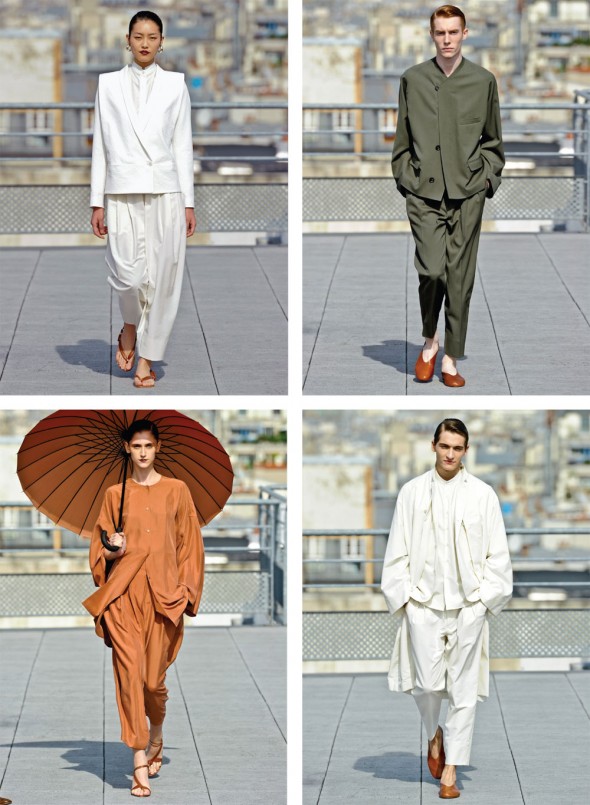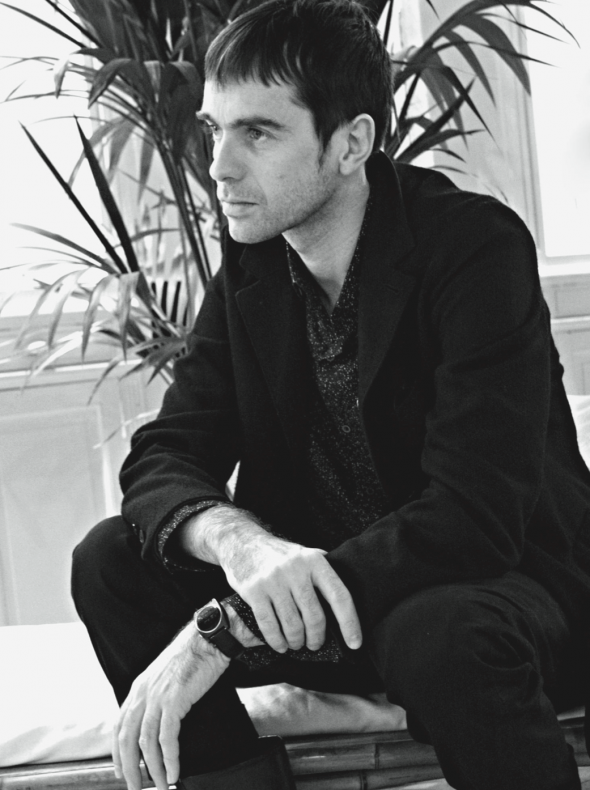Christophe Lemaire, as it turns out, is not effusive about fashion. He’s measured, and thoughtful, and opinionated, and smart, and funny, and kind, and generous—but no, not effusive. And he’s not interested in fame or celebrity. He wants to design and produce the best, and he wants to like what he’s doing. Which—when you think about it—is fitting for someone who successfully runs his own line, Christophe Lemaire, and has revitalized the done-to-death brand of Lacoste. And now he is about to become the Creative Director of womenswear for arguably the most luxurious fashion house in existence: Hermès.
I sat down with the man who is poised to be one of the most powerful arbiters of style out there.
Here’s what I learned. Lemaire considers his childhood to be boring and typical of a French bourgeois family. I’ll give you the basics: Divorced parents, a bohemian family, travel between Paris and Senegal, the dramas of boarding school, and ultimately, a creative, young man.
Lacking the cash to pay the rent, Christophe landed a job as an assistant stylist for Thierry Mugler. What was simply a way to earn money became a passion. “Funnily enough,” Lemaire muses, “I only started to realize I was interested in fashion when I started working as a fashion assistant. I was always interested in style, but not necessarily fashion. I had more of an interest in interior design, objects and fashion as everyday life. And I was a student, studying literature, wanting to study decorative arts.”
Lemaire has certainly acquired a storied education none- theless. He studied under Yves Saint Laurent and Thierry Mugler, and had a four-year stint as an assistant at Christian Lacroix. He eventually became the manager of the Lacroix ready-to-weardepartment while developing his own line, show- ing a precocious talent for creative multitasking.
Lemaire’s feelings about studying under so many greats are mixed. “At one point, I was about to stop fashion. I felt like, because I wasn’t gay and wasn’t obsessed with fashion shows, that maybe I was not doing the right thing. I felt like an out- sider. I was interested in street style. At that time there seemed to nothing between couture and mass market fashion, just one or the other.” Luckily, for us, he continued to create. Instead of falling prey to aesthetic schizophrenia, Lemaire honed his own vision. “I guess I just grew up and listened to who I am. From [Mugler, Saint Laurent and Lacroix], I learned a sense of style, a feel for colors, a way of remembering. Then I made my way. What’s interesting is to bring my own vision of things.” Lemaire started sending his own disco, African and Asian-infused col- lections. Soon after, he launched his own line of womenswear in 1991, and menswear in 1995.
Of the early days of the Christophe Lemaire line, Lemaire recalls, “I started with womenswear that was very structured, very tailored—a lot of tweed, Harris tweeds. They were very much inspired by Hitchcock movies from the ‘40s. It’s like I jumped into water before learning how to swim!” Lemaire did collaborations between his brand and more niche luxury brands like Wrangler Japan, Dorothée Bis and Woolmark. Yet running and designing his own brand at such a young age took its toll: “I found myself stuck with very practical things: production, finance, business, dealing with a team. I was managing and designing. I became alienated by doing both. After a while it became really stressful. I couldn’t concentrate on design and creative work because I was too bogged down in business-related things. By the end, it was no longer a pleasure. I learned a lot, but in some ways, it was a failure in the end, because I decided to stop the collection after starting work with Lacoste.”
Lacoste had become the go-to brand for the rich and the preppy by the ’80s—the frenetic, insecure energy of the rich high school kid; the soft-bellied dad earnestly playing golf; the languid sexiness of bored housewives. It all seemed new at first, yet by the ‘90s, the look was stale—a tired mockery of what it had been.
It took Lemaire’s appointment in 2000 to revitalize the brand. “I wanted to bring some style back to the brand, back to what it was in my mind: Sports chic. The clothes needed to be coherent with the new lifestyle.” And so it happened. Within a few years, Lacoste went from trite and preppy to urbane and prepster. Lemaire introduced more upscale lines, like the “Club” range of clothes and the “Life!” line. He launched Lacoste seasonal fashion shows in New York, presenting looks that played with proportion and creating classics with a twist. Before Lemaire, Lacoste was limited to white suburbia. Now, it’s likely that the young Parisians attending the gallery open- ings on rue Debelleyme own something from the neighbor- hood Lacoste. And no, it’s probably not a polo.
Lemaire has produced great collections for both Lacoste and his eponymous line since he decided to start it up again in 2006. While his brand has been cohesive over time, his taste has become more quiet and refined since its reinstatement. “Some say it’s a bit austere, puritan, but I don’t mind! I like the idea of dignity. When I look at traditional style, it’s something very timeless and never difficult—I’m inspired by that. I bring that in my vision of fashion.” The difference in the austerity is particularly pronounced after he assumed financial ownership of his boutique and design team.

At this point, the Christophe Lemaire brand has a dis- tinct style to go along with its well-earned independence. Everything is in earthy hues, from forest green, to navy blue, to dark camel. The pieces are fluid and loosely tailored, with a distinct East-meets-West vibe. The fabrics are durable, and lovely, but not in-your-face luxurious. Since Lemaire’s vision is so developed, recommending particulars based on season feels like an affront to the mindset of his brand. (I will say, however, that the Japanese-inspired mid-calf skirts in grey tweed, all of the beautifully-draped-yet-relaxed pants for either sex, and the full-bodied parkas are particularly notable this season.)
Ultimately, though, Lemaire says that he would prefer to help us build our own daily uniforms: “I don’t like buying something that I’ll throw out in three months because it’s of poor quality or off trend. I don’t think you have to change your wardrobe every six months. You build your wardrobe. Elegance is what I’m after, and it’s the quality of the fabric, the cut, the details, the color. That’s my job. At the end of the day, it’s not the clothes that make style; it’s the person himself. I like the essential dimension of fashion. That’s what I think I’m best at. Helping each and every person find his own uniform.”
Christophe Lemaire pieces are to be added carefully and collected over time. The Christophe Lemaire client, despite what Lemaire himself may want, is particular and discerning: “I definitely think I’m addressing someone who thinks the way I’m thinking, which is a desire to distance himself from con- sumerist culture. He’s probably someone who is aware, with a little bit of culture, and trying to create his own style. Someone free-spirited—a free woman or free man that looks for his own style instead of something trendy. I’m aware that my clothes are not very mainstream. But I’m not at all someone elitist! They are made for a subtle customer who prefers to build a precise, long-lasting wardrobe and who eschews trendiness.”
This seems as good a time as any to discuss Lemaire’s new appointment at a brand that probably does that best at consis- tently offering pieces that withstand the constantly changing trends of the fashion elite. Honestly, when I first read the news that Lemaire was set to replace Gaultier at Hermès starting in Fall 2011, I thought the decision was odd. I expected them to appoint someone famous, a fashion celebrity of the Marc Jacobs-echelon, so I set out to learn more about Hermès. Everything I learned about Hermès supports my conviction that Hermès made the right decision in appointing Lemaire.
First, a little history: Hermès was founded in 1837 and started out as a harness workshop near Madeleine in Paris. The house made its first forays into fashion in 1902: The Hermès family developed the haut à courroies (now known as the Kelly bag) and the sac pour l’auto (known as the Bolide). They’ve been the house’s main source of fame ever since. Over time, Hermès embraced collaborations, enlisting artists to design special products and providing leather products for automo- biles. In 1929, they introduced their first women’s line. To make a long story short, they’re now a multinational company with many divisions.
In 2003, Jean Paul Gaultier took the reigns as womenswear designer for Hermès. Gaultier’s collections always have the same trappings: a distinct theme, usually involving a traveler. Always playful, but interspersed with classics that you would be happy to have in your wardrobe. It’s no surprise to me that Lemaire was strongly considered for the position of creative director. Lemaire’s experience with Lacoste, his willingness to collaborate and expand, and his ability to run his own, smaller business successfully enough to buy it back, gives ample evi- dence that he is an extraordinary designer and businessman.
More importantly, his style and the style of Hermès share several essential themes in common. The strong Asian refer- ences seen in Lemaire’s tailoring and inspirations are all over the Hermès runway in the forms of colors, dyes and themes. (Its Spring 2008 collection had a distinct Indian feel.) Both brands continually choose smart, richly dyed, and often earthy colors over trendy and flashy ones; Hermes also forgoes trendy synthetic fabrics in favor of luxe, natural ones. Gaultier and Lemaire seem to love putting women in clothes that are clas- sically made for men, but tailored to compliment women (even a brief glance over their Fall/Winter 2010 lookbooks would convince you of such). The Hermès show for last spring waseven tennis-themed! Ultimately, and most importantly though, both brands are about building a wardrobe from classic, subtle pieces that you will keep forever.
Lemaire himself feels much the same way as I do. Of his appointment at Hermès, he acknowledges, “Of course I’m very, very happy and very proud they thought of me. It’s a real reward, and a very beautiful challenge for me.” But he is more than just thankful. He understands his shared interest with Hermès on the importance of timeless pieces over trendy fashion: “The Hermès style very much fits with everything I’ve been talking about. At Hermès, it’s more about timeless fashion, quality and style. I’m also incredibly proud because it’s one of the very last big luxury companies with ethics. There’s a true ethic there, and a true sense of responsibility towards crafts, quality and real luxury. Now I have to prove that they made a good choice.” This last phrase is very much in keeping with Lemaire’s personality: serious, considerate and ready to work towards perfection, just as Hermès strives for perfection for its own garments.
So once again we return to timelessness. While the heritage and the look of both Hermès and Lemaire’s designs may be inspired by the perpetual traveler, their clothes remain at rest, in your closet, always highly treasured. I’d like to think that Lemaire, if he chooses to, will be as much a fixture at Hermès, and in the fashion world as a whole, as their Birkin, Constance and Kelly bags. Always for those in the know: the right choice, the right style, evolving slowly yet surely, and always of the highest quality.
– Max Kessler


